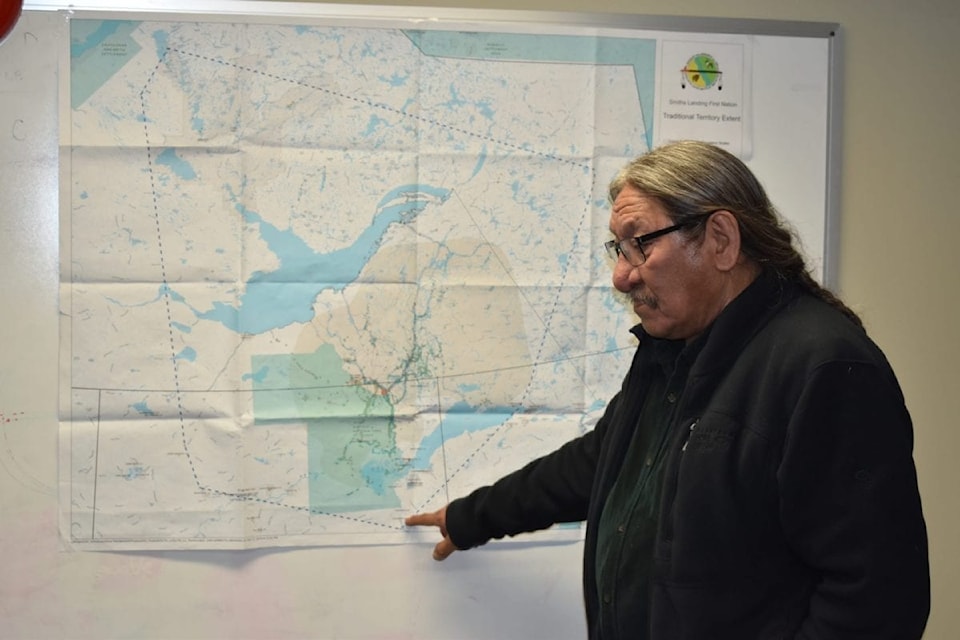This letter was submitted to Minister of Environment and Natural Resources Shane Thompson on behalf of Gerry Cheezie, Chief of Smith's Landing First Nation, Jan. 29.
Dear Minister Thompson:
I write to express Smith's Landing First Nation's ("SLFN") frustration with the Crown's failure to meaningfully consult and accommodate SLFN on the Teck Resources Limited ("Teck") Frontier Oil Sands Mine Project ("Project") located south of Wood Buffalo National Park ("WBNP"). The Impact Assessment Agency of Canada ("IAAC") has submitted its Crown Consultation Report to the Minister of Environment and Climate Change Canada ("Minister of Environment") and we are concerned that the Minister of Environment does not have sufficient information on downstream impacts to the land north of 60 and the transboundary waters flowing from Alberta into the Northwest Territories to determine whether or not to approve the Project (anticipated decision on February 20, 2020).
We are requesting that you support SLFN in protecting not only our Territory and Treaty rights, but the lands, water, and people across the NWT. As such, we outline our outstanding concerns below and request that you stand with SLFN to advocate for meaningful consultation and accommodation of our Treaty rights and interests as the protection of our rights will mean continued protection for all NWT.
Inadequacy of Crown consultation
SLFN is a signatory of Treaty No. 8 (the "Treaty") and are the descendants of the traditional Tthebatthi (ahead of the rapids, referring to the first set of rapids on the Slave River) Denesuhne (people of the land) of the Great Slave region. Inclusive of the extent of Treaty 8, SLFN Territory encompasses both Treaty and sovereign lands within northern Alberta, WBNP, NWT, northern Saskatchewan, northern Manitoba, and southern Nunavut. Members of SLFN hold an innate connection to their Territory and continue to actively use the land, waters and resources to sustain their cultural way of life. The Project is located within our Territory and if approved, will be the largest, open pit oil sands mining project in Alberta, located within kilometers of WBNP, a World Heritage Site with incredibly fragile Outstanding Universal Values, as demonstrated in through the UNESCO/World Heritage Committee Mission and resulting Strategic Environmental Assessment and Action Plan.
It has been SLFN 's experience to be unjustifiably ignored by proponents and the Crown with respect to development occurring in our Territory resulting in adverse, direct, indirect and cumulative impacts on our Treaty rights. The Project is no exception. Both Teck and the provincial Crown maintain that SLFN is not impacted by the Project and as such, consultation is not required based on the false assumption that we are located too far north of the Project.
It was not until the JRP Amended Agreement was issued in August 2017 that the federal Crown recognized SLFN as a potentially affected Aboriginal group and provided funding to SLFN for our participation in the remaining stage of the environmental assessment ("EA"). Throughout the EA and Crown consultation process we have repeatedly stated that SLFN continues to be impacted by development located south of WBNP as far north as Fort Smith, NWT and we are concerned that the Project will further impact the land, water and resources in our Territory.
Canada has failed to meaningfully consult and accommodate SLFN 's concerns. The Crown consultation team has treated the consultation process as a forum for SLFN to "blow off steam" rather than a two-way process of information sharing.
The Crown consultation team has simply repackaged the incorrect findings and conclusions of the JRP with respect to the potential impacts of the Project on SLFN in its impacts assessment of the Crown Consultation Report, further reduced our concerns to water and caribou, and devalued the significance of the Project's contribution to the cumulative effects on SLFN's Treaty rights and interests.
Protecting the transboundary waters flowing north from Alberta to NWT is a key concern of SLFN and as such, we have requested repeatedly that Canada require a SLFN-Jed community-based water monitoring program ("CBWMP") to monitor the impacts of development on the Slave River as a condition of the Project. Alternatively, if the Project does not proceed, SLFN requested that Canada fund the CBWMP to mitigate impacts from current and future downstream development on SLFN.
To SLFN's dismay, the Crown consultation team has limited their mandate to being note-takers and has refused to depart from the JRP's findings and recommended conditions. As such, the Crown has refused to recommend the CBWMP as a measure to mitigate impacts of the Project on SLFN based on the false assumption that the Project will not contribute to the cumulative impacts on SLFN's Treaty rights.
Conclusion
The Project creates a fear and real risk to members of SLFN and residents of the NWT who rely on lands and water to sustain their way of life. We believe that this Project will breach the Alberta NWT Mackenzie River Basin Bilateral Water Management Agreement as well as the Canada Water Act (protecting waters flowing through WBNP). As such, we strongly urge you to stand with us in opposing this Project.
